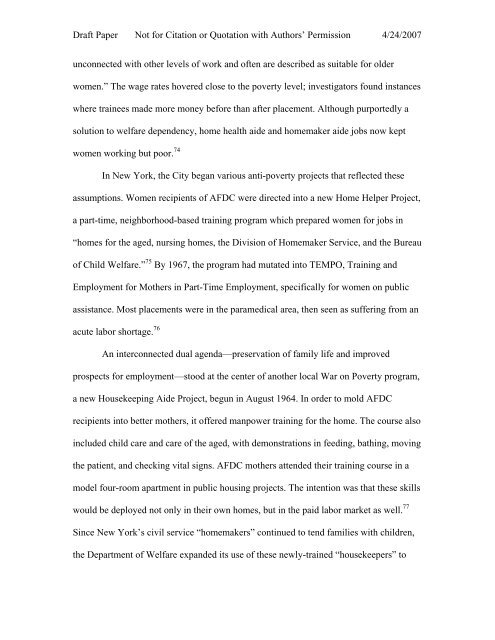Organizing Home Care: - School of Social Service Administration
Organizing Home Care: - School of Social Service Administration
Organizing Home Care: - School of Social Service Administration
You also want an ePaper? Increase the reach of your titles
YUMPU automatically turns print PDFs into web optimized ePapers that Google loves.
Draft Paper Not for Citation or Quotation with Authors’ Permission 4/24/2007<br />
unconnected with other levels <strong>of</strong> work and <strong>of</strong>ten are described as suitable for older<br />
women.” The wage rates hovered close to the poverty level; investigators found instances<br />
where trainees made more money before than after placement. Although purportedly a<br />
solution to welfare dependency, home health aide and homemaker aide jobs now kept<br />
women working but poor. 74<br />
In New York, the City began various anti-poverty projects that reflected these<br />
assumptions. Women recipients <strong>of</strong> AFDC were directed into a new <strong>Home</strong> Helper Project,<br />
a part-time, neighborhood-based training program which prepared women for jobs in<br />
“homes for the aged, nursing homes, the Division <strong>of</strong> <strong>Home</strong>maker <strong>Service</strong>, and the Bureau<br />
<strong>of</strong> Child Welfare.” 75 By 1967, the program had mutated into TEMPO, Training and<br />
Employment for Mothers in Part-Time Employment, specifically for women on public<br />
assistance. Most placements were in the paramedical area, then seen as suffering from an<br />
acute labor shortage. 76<br />
An interconnected dual agenda—preservation <strong>of</strong> family life and improved<br />
prospects for employment—stood at the center <strong>of</strong> another local War on Poverty program,<br />
a new Housekeeping Aide Project, begun in August 1964. In order to mold AFDC<br />
recipients into better mothers, it <strong>of</strong>fered manpower training for the home. The course also<br />
included child care and care <strong>of</strong> the aged, with demonstrations in feeding, bathing, moving<br />
the patient, and checking vital signs. AFDC mothers attended their training course in a<br />
model four-room apartment in public housing projects. The intention was that these skills<br />
would be deployed not only in their own homes, but in the paid labor market as well. 77<br />
Since New York’s civil service “homemakers” continued to tend families with children,<br />
the Department <strong>of</strong> Welfare expanded its use <strong>of</strong> these newly-trained “housekeepers” to
















